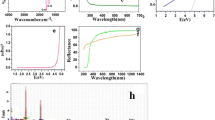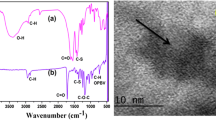Abstract
The Mn2+ and Mo6+ based metal-mercaptoacetate (metal-MA) hybrids were prepared by a simple acid–base titration method. The prepared metal-MA hybrids were analysed by FT-IR spectroscopy, UV–visible spectroscopy, SEM, particle size analyser (PSA), XRD and EDX. The prepared metal-MA hybrids were investigated to assess their catalytic activity for ring-opening polymerization (ROP) of ε-caprolactone (CL) in the absence of an initiator at 160 °C in N2 atmosphere by varying the catalyst concentration and temperature. The catalytic activity of the metal-MA hybrid towards the ROP of CL was evidenced by the FTIR-RI method. The % yield, degradation temperature (Td), melting temperature (Tm) and molecular weight (Mw) of poly(ε-caprolactone) (PCL) were also investigated. The structure of PCL was comprehended by analysing its NMR spectrum. The activation energy (Ea) for the ROP of CL was determined as 10,363 kcal/mol. A linear increase in Mw of PCL with the increasing [M0/I0] ratio was also noticed.
Graphical abstract












Similar content being viewed by others
References
Malikkmammadov E, Tahir TE, Kiziltay A, Hasirei V (2018) PCL and PCL-based materials in biomedical applications. J Biomater Sci Polym Ed 29:863–893
Meenarathi B, Siva P, Jeyapriya M, Anbarasan R (2018) Synthesis, characterization, catalytic reduction, and splinting activity of poly(ε-caprolactone–co–morpholine)/Ag nanocomposite. Adv Polym Technol 37:1–9
Anbarasan R, Jeyapriya M, Meenarathi B (2018) Low temperature splinting activity and catalytic behavior of nano Ag doped sulphamicacid bridged diblock copolymer. Polym Adv Technol 29:2025–2035
Talebi A, Labbaf S, Karimzadeh F (2019) Polycaprolactone-chitosan-polypyrrole conductive biocomposite nanofibrous scaffold for biomedical applications. Polym Compos 25395:1–8
Abinayasri P, Meenarathi B, Anbarasan R (2017) Synthesis of fluorescent diblock copolymer nanoparticle supported catalyst for the reduction of Cr(VI), p-nitrophenol and rhodamine6G dye: a comparative study. Bull Mater Sci 40:591–598
Sladdery RM, Stahl AE, Bereton KR, Rheingold AL, Fritsch JM (2019) Ring opening polymerization and copolymerization of L-lactide and ɛ-caprolactone by bis-ligated magnesium complexes. J Polym Sci Part A Polym Chem 57:48–59
Raghavendra B, Bakthavachalam K, Ramakrishna B, Reddy ND (2017) N-Benzoylbenzamidinate complexes of Magnesium: Catalysts for the ring-opening polymerization of ε-caprolactone and CO2/Epoxide coupling. Organomet 36:4005–4012
Mandal M, Luke AM, Tolman WB, Cramer CJ (2019) Mechanistic analysis and catalyst design for sustainable polymer production. ACS Catal 9:885–889
Zhu D, Guo L, Zhang W, Hu X, Zhang Q, Sun WH (2019) Dialkylaluminum 2-substituted 6,6-dimethylcyclopentylpyridin-7-oxylates toward structural-differentiation of the ring-opening polymerization of ε-caprolactone and L-lactides. Dalton Trans 48:4157–4167
Bowyahya A, Balieu S, Gounier G, Lanchin M (2019) Organotin-bridged ionic liquid as a solvent-free, leaching-resistive catalyst for ring opening polymerization of ε-caprolactone. New J Chem 43:5872–5878
Galia A, Scialdhene O, Spano T, Tilloy S, Roysseau C (2016) Ring opening polymerization of ε-caprolactone in the presence of wet β-cyclodextrin: effect of the operative pressure and of water molecules in the β-cyclodextrin cavity. RSC Adv 6:90290–90299
Rosal ID, Poteau R, Maron L (2011) DFT study of the ring opening polymerization of ε-caprolactone by grafted lanthanide complexes: 2-Effect of the initiator ligand. Dalton Trans 40:11228–11240
Alamri H, Zhao J, Polhounik D, Hadhjichristidis N (2011) Phosphazene-catalyzed ring-opening polymerization of ε-caprolactone: influence of solvents and initiators. Polym Chem 5:5471–5478
Xu J, Song J, Pispas S, Zhang G (2014) Metal-free controlled ring-opening polymerization of ε-caprolactone in bulk using tris(pentafluorophenyl)borane as a catalyst. Polym Chem 5:4726–4733
Karmel R, Khononov M, Tamm M, Eisen MS (2015) Uranium-mediated ring-opening polymerization of ε-caprolactone: a comparative study. Catal Sci Technol 5:5110–5119
Scrivanti A, Bortoluzzi M, Gatto M (2016) New heteroscorpionate lanthanide complexes for ring-opening polymerisation of ε-caprolactone and rac-lactide. Chem Pap 70:53–60
Fan L, Zhang L, Shen Z (2004) Analysis of crystalline structure and morphology of isotactic polypropylene under the coexistence of organic montmorillonite particles and shear flow. Polym J 36(2004):91–95
Kayan A (2020) Recent studies on single site metal alkoxide complexes as catalysts for ring opening polymerization of cyclic compounds. Catal Surv Asia 24:87–103
Liu DF, Zhu LQ, Wu J, Lu XQ (2015) Ring-opening copolymerization of epoxides and anhydrides using manganese(III) asymmetrical Schiff base complexes as catalysts. RSC Adv 5:3854–3859
Yang Z, Duan R, Sun Z, Zhang H, Li L (2019) Salen-Manganese complexes and their application in the ring-opening polymerization of lactide and ϵ-caprolactone. Asian J Org Chem 8:376–384
Bijja R, Chakraborty D (2014) Co(II) and Mn(II) catalyzed bulk ring-opening polymerization of cyclic esters. Polym Bull 71:2185–2203
Autenrieth B, Jeorge HS, Axtell B (2015) Stereospecific ring-opening metathesis polymerization (ROMP) of endo-dicyclopentadiene by Molybdenum and Tungsten catalysts. Macromolecules 48:2480–2492
Yang W, Zhao KQ, Redshaw C, Elsegood J (2015) Molybdenum complexes derived from the oxydianiline [(2-NH2C6H4)2O]: synthesis, characterization and ε-caprolactone ROP capability. Dalton Trans 44:13133–13140
Bai J, Xiao X, Zhang Y, Chao J, Chen X (2017) β-Pyridylenolate zinc catalysts for the ring-opening homo- and copolymerization of ε-caprolactone and lactides. Dalton Trans 46:9846–9858
Fuoco T, Pallalardo D (2017) Aluminum alkyl complexes bearing alicylaldiminato ligands: versatile initiators in the ring-opening polymerization of cyclic esters. Catalyst 7:64–68
Mahha Y, Atlasani A, Blais JC, Salles L (2005) Oligomerization of ɛ-caprolactone and δ-valerolactone using heteropolyacid initiators and vanadium or molybdenum complexes. J Mol Catal A Chem 234:63–73
Alkareshni W, Armitage AP, Singh K (2013) Phenolate substituent effects on ring-opening polymerization of ε-caprolactone by Aluminum complexes bearing 2-(phenyl-2-olate)-6-(1-amidoalkyl)pyridine pincers. Orgaonomet 32:249–259
Redshaw C (2017) Use of metal catalysts bearing Schiff base macrocycles for the ring opening polymerization (ROP) of cyclic esters. Catalyst 7:165–176
Thomas C, Gladysz JA (2014) Highly active families of catalysts for the ring-opening polymerization of lactide: Metal templated organic hydrogen bond donors derived from 2-Guanidinobenzimidazole. ACS Catal 4:1134–1138
Oleiveira ALC, Ferreira LC, Nascimento MAC (2019) Ring opening polymerization of l-lactide with two different zinc(ii) phenoxy-imine complexes as initiators. Quim Nova 42:505–512
Giese SOK, Egervardt C, Nunes GG (2015) Catalytic activity of a Titanium(IV)/Iron(II) heterometallic alkoxide in the ring-opening polymerization of ε-caprolactone and rac-lactide. J Braz Chem Soc 26:2258–2268
Jiang L, Lou L, Sun W, Xu L, Shen Z (2005) Ring opening polymerization of ε-caprolactone with a divalent samarium bis(phosphido) complex. J Appl Polym Sci 98:1558–1564
Ajsuvakova OP, Skalnaya MG, Michalke B (2021) Alteration of iron (Fe), copper (Cu), zinc (Zn), and manganese (Mn) tissue levels and speciation in rats with desferioxamine-induced iron deficiency. Biometals 34:923–936
Debosree G, Parthasarathi S, Syed BF, Pratap P, Debjani G (2016) Biometals in health and disease: A review. World J Pharm Res 5:390–399
Anbarasan R, Kannammal L, Parthasarathy V, Tung KL (2019) Synthesis, characterization and ring opening activity of barium mercaptoacetate towards ε-caprolactone. Polym Bull 76:5381–5397
Bahramian B, Mirkhani V, Moghadam M, Amin AH (2006) Water-soluble manganese(III) salen complex as a mild and selective catalyst for oxidation of alcohols. Appl Catal A Gen 315:52–57
Sehimi H, Zid MF (2018) A novel Mn(II) oxalato-bridged 2D coordination polymer: synthesis, crystal structure, spectroscopic, thermal and magnetic properties. J Chem Sci 130:25–34
Chen HH, Anbarasan R, Chen PH (2012) Fabrication of hierarchical structured superhydrophobic Copper surface by insitu method with micro/nano scaled particles. Mater Lett 66:299–301
Choi WS, Chisholm MF, Singh DJ (2012) Nature Commun 3:689–695
Mandal M, Monkowius U, Chakraborty D (2016) Cadmiumacetate as a ring opening polymerization catalyst for the polymerization of rac-lactide, ε-caprolactone and as a precatalyst for the polymerization of ethylene. J Polym res 23:220
Kannammal L, Meenarathi B, Anbarasan R (2014) Synthesis, characterization and band gap energy of poly(caprolactone)/Sr-MSA nanocomposites. J Phys D Appl Phys 47:135109
Fan W, Leng Y, Liu J, Jiang P, Zhao J (2015) Mo Schiff base-tungstate ionic hybrid with enhanced heterogeneous catalytic activity for epoxidation reactions. Appl Catal A Gen 506:173–179
Anbarasan R, Kohila V, Meenarathi B, Jeyalakshmi G, Jancirani A (2019) Synthesis, characterization and non-isothermal degradation kinetics of poly(ε-caprolactone)/Fe3O4-dye nanocomposites. SN Appl Sci 1:602–614
Kannammal L, Meenarathi B, Parthasarathy V, Anbarasan R (2021) Synthesis and characterization of metal-mercaptoacetate hybrids and its application towards ring opening polymerization of ε-caprolactone: A comparative study. Res Squ. https://doi.org/10.21203/rs.3.rs-308770/v1
Anbarasan R, Meenarathi B, Parthasarathy V (2021) Structural and thermal studies on fluorescein and rhodamine6G grafted diblock copolymer. J Inorg Organomet Polym Mater 31:3549–3561
Author information
Authors and Affiliations
Corresponding author
Ethics declarations
Conflict of interest
All the authors have no conflict of interest.
Additional information
Publisher's Note
Springer Nature remains neutral with regard to jurisdictional claims in published maps and institutional affiliations.
Rights and permissions
About this article
Cite this article
Kannammal, L., Meeenarathi, B., Parthasarathy, V. et al. Synthesis and characterization of metal-mercaptoacetate hybrids and its application towards ring-opening polymerization of ε-caprolactone: a comparative study. Polym. Bull. 79, 9001–9023 (2022). https://doi.org/10.1007/s00289-021-03939-9
Received:
Revised:
Accepted:
Published:
Issue Date:
DOI: https://doi.org/10.1007/s00289-021-03939-9




